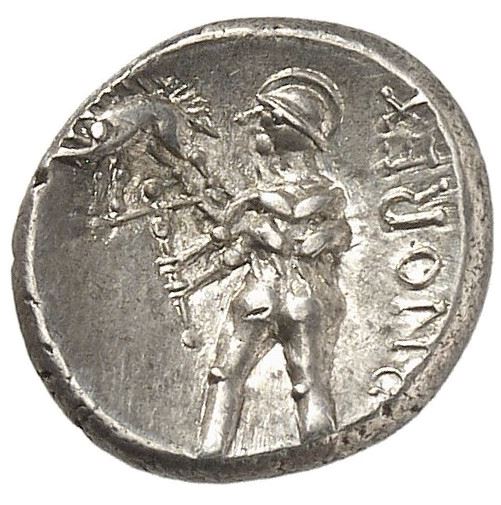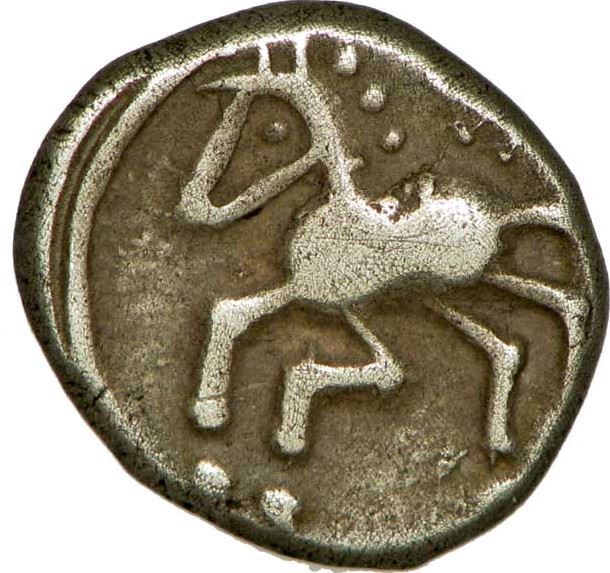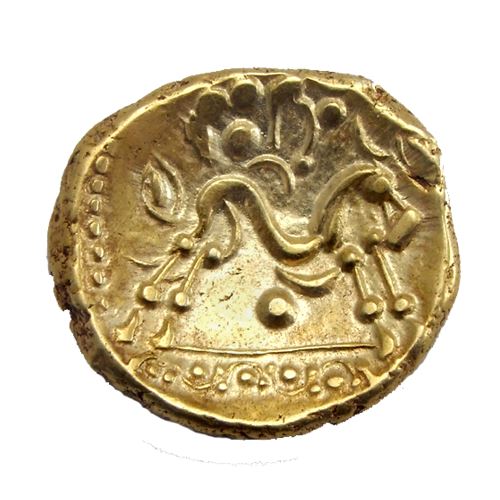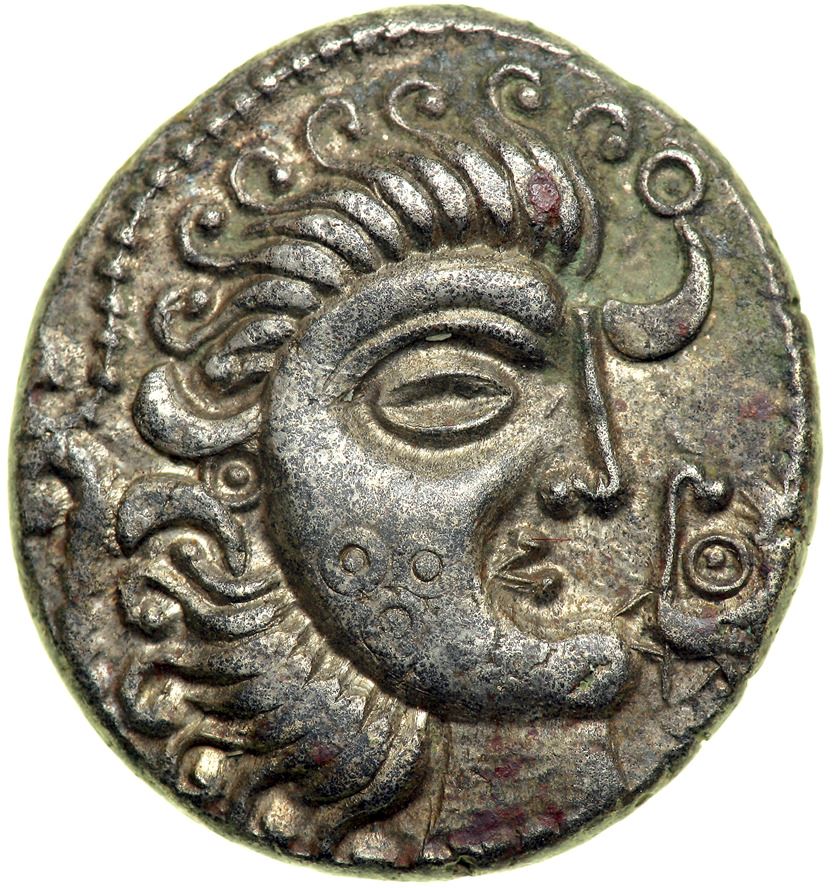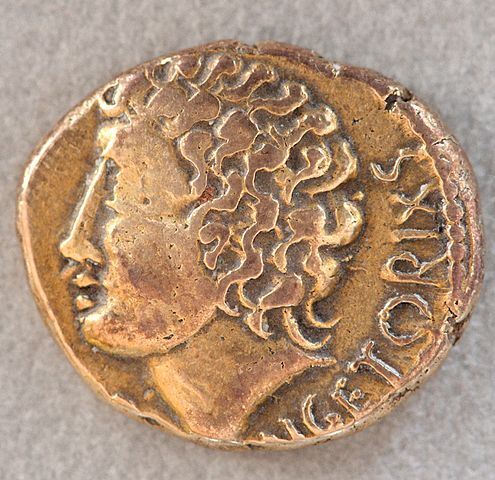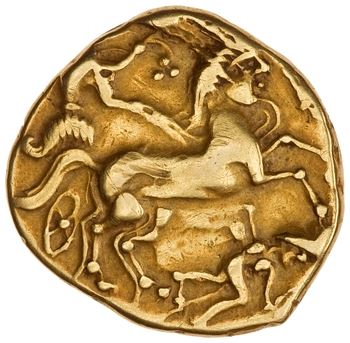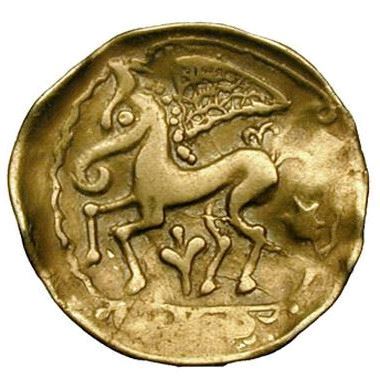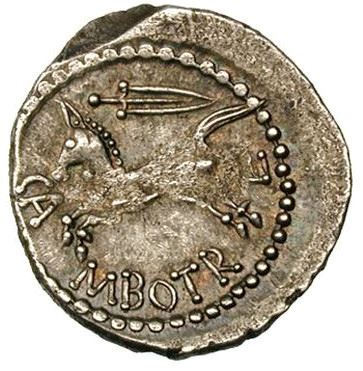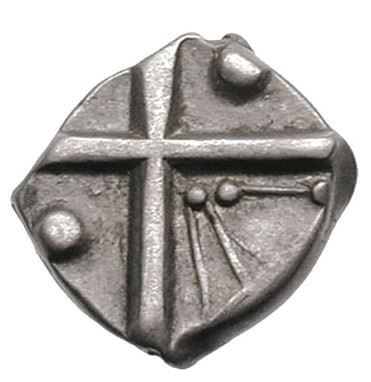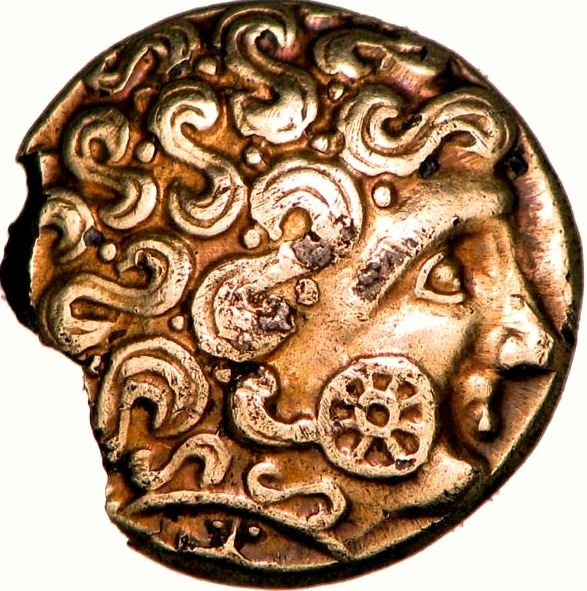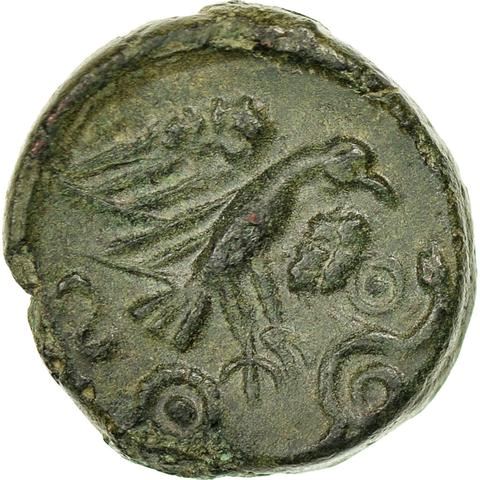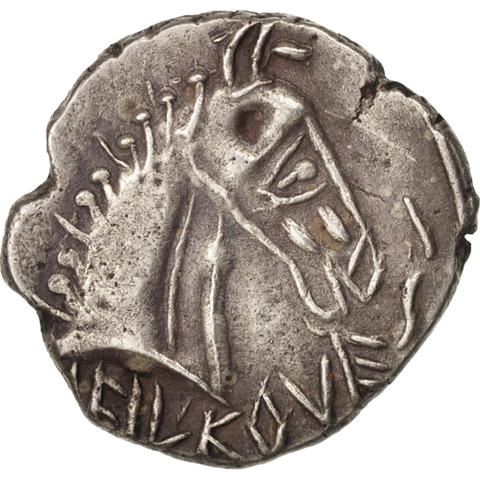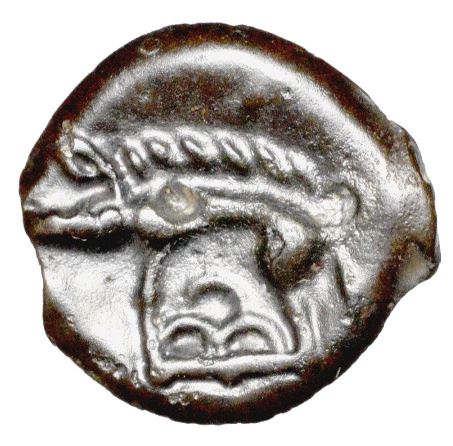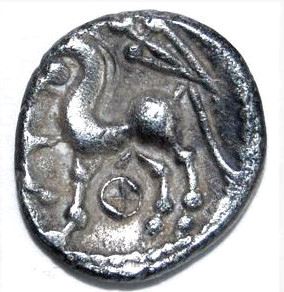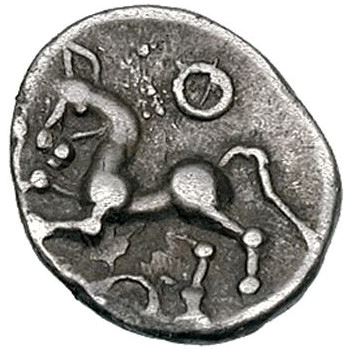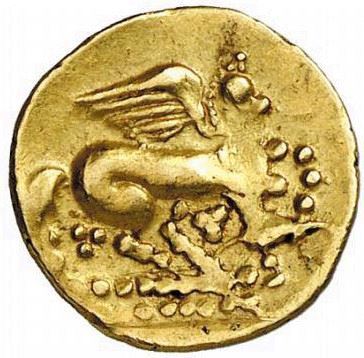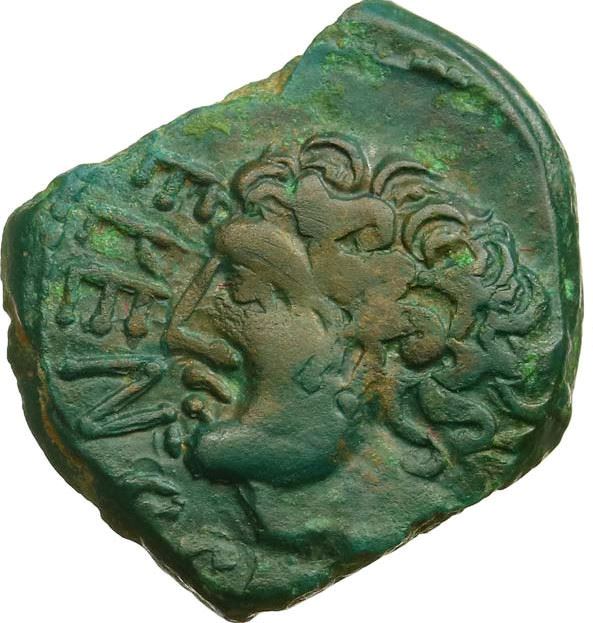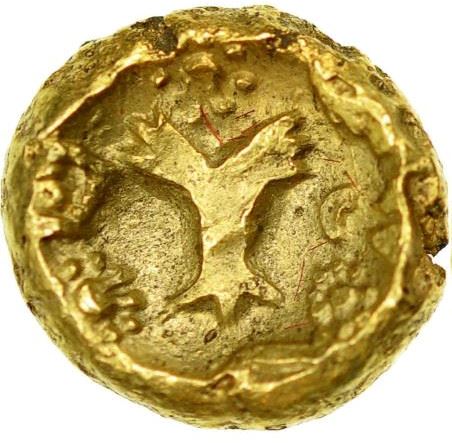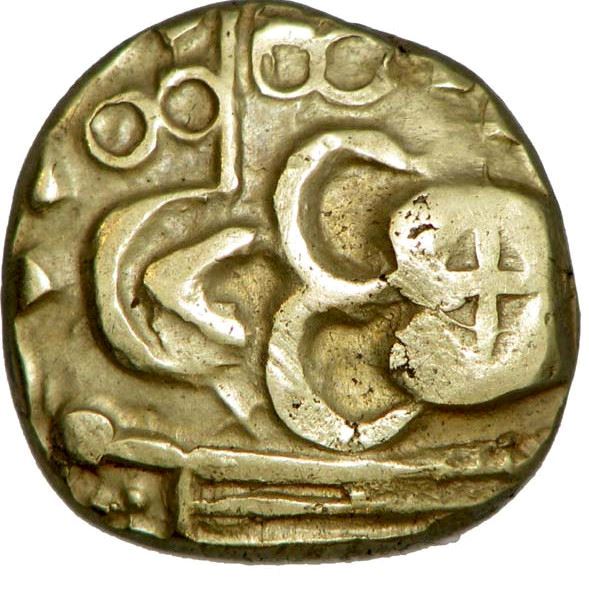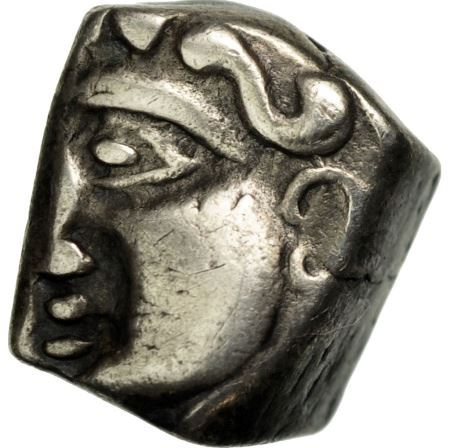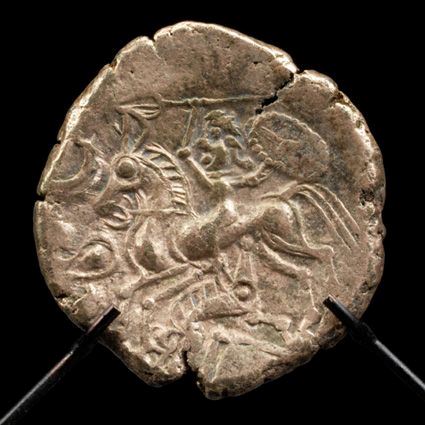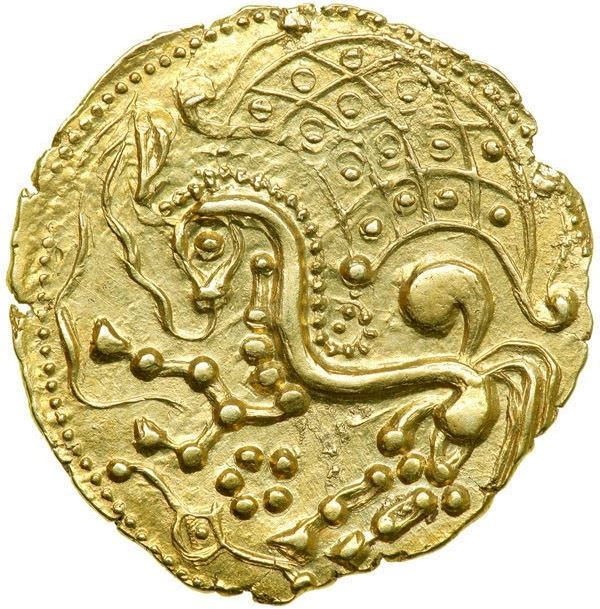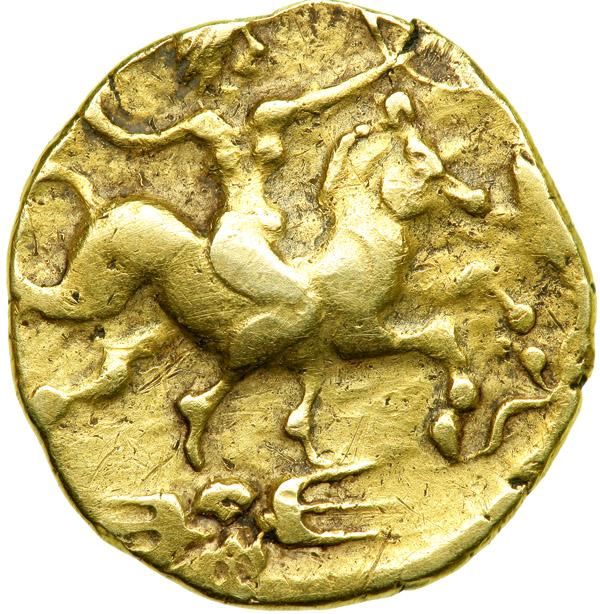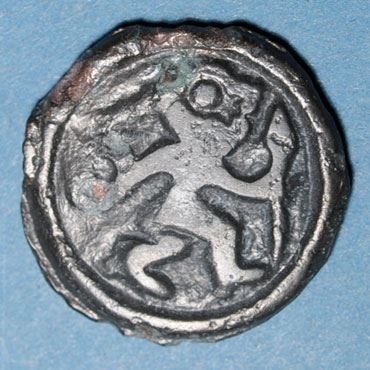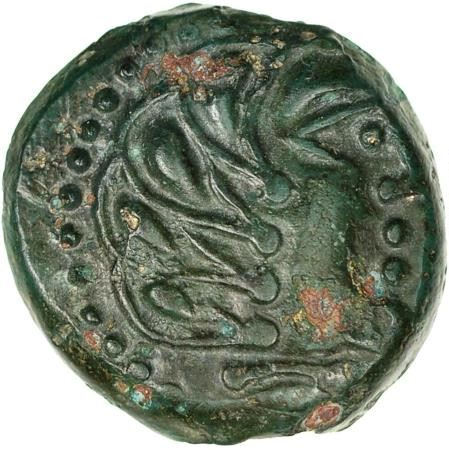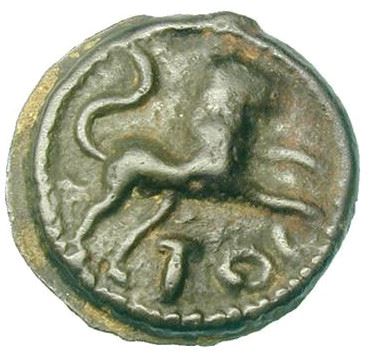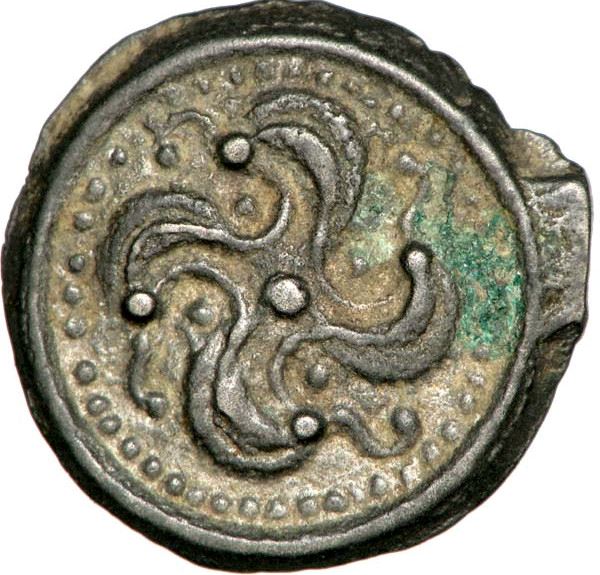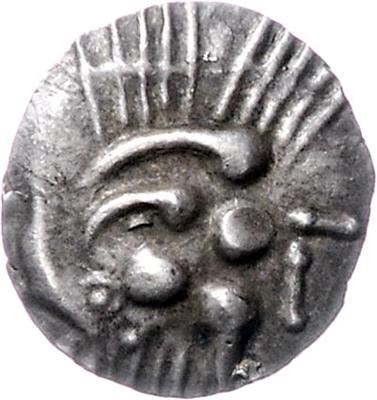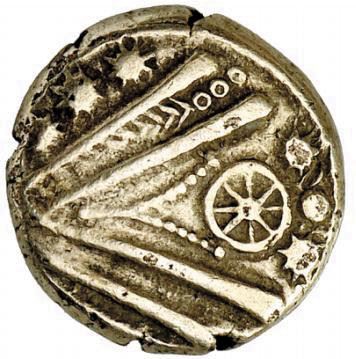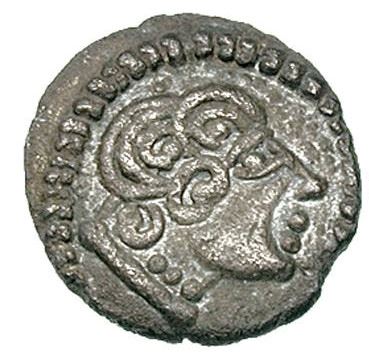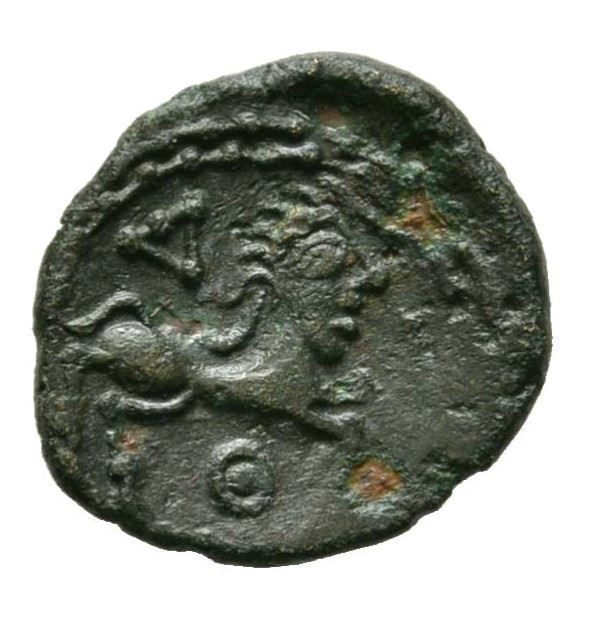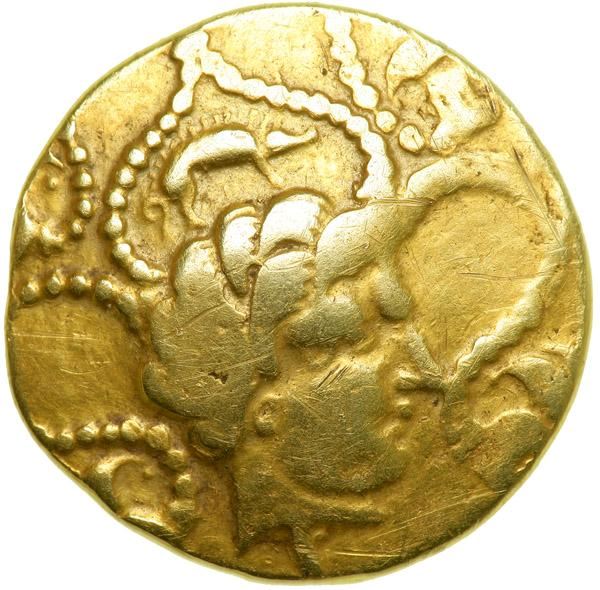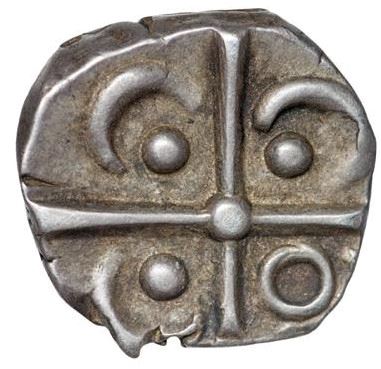Gaul was a region of Western Europe during the Iron Age that was inhabited by Celtic tribes.
Coinage in Gaul started with the Greek colonies of Massalia, Emporiae, and Rhoda - and designs from these three cities were widely copied across southern Gaul. Northern Gaulish coins were especially influenced by the coinage of Philip II of Macedon and Alexander the Great.
Celtic coins often retained Greek subjects, such as the head of Apollo on the obverse and two-horse chariot on the reverse of the gold stater of Philip II, but developed their own style from that basis, allowing for the development of a Graeco-Celtic synthesis.
With the Roman invasion of Gaul, Greek-inspired Celtic coinage started to incorporate Roman influence instead, until it disappeared to be completely replaced by Roman coinage.
Coinage in Gaul started with the Greek colonies of Massalia, Emporiae, and Rhoda - and designs from these three cities were widely copied across southern Gaul. Northern Gaulish coins were especially influenced by the coinage of Philip II of Macedon and Alexander the Great.
Celtic coins often retained Greek subjects, such as the head of Apollo on the obverse and two-horse chariot on the reverse of the gold stater of Philip II, but developed their own style from that basis, allowing for the development of a Graeco-Celtic synthesis.
With the Roman invasion of Gaul, Greek-inspired Celtic coinage started to incorporate Roman influence instead, until it disappeared to be completely replaced by Roman coinage.
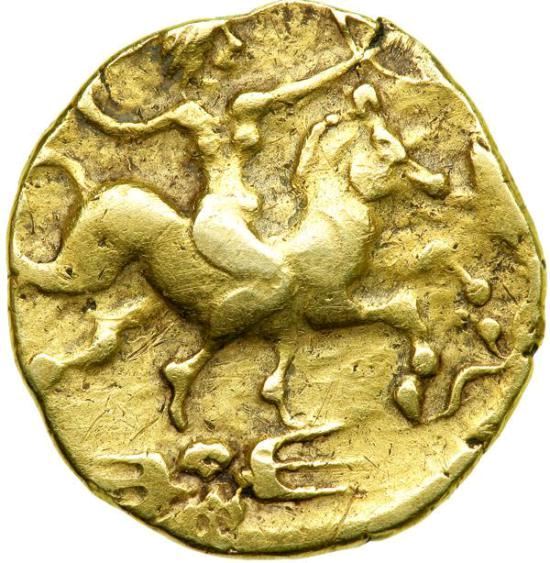
The Aedui were a Gallic people of Gallia Lugdunensis, who inhabited the country between the Arar (Saône) and Liger (Loire), in today's France.
The Aedui, like other powerful tribes in the region had replaced their monarchy with a council of magistrates called grand-judges. The grand-judges were under the authority of the senate. The senate was made up of the descendants of ancient royal...
The Aedui, like other powerful tribes in the region had replaced their monarchy with a council of magistrates called grand-judges. The grand-judges were under the authority of the senate. The senate was made up of the descendants of ancient royal...
The Allobroges were a Gallic tribe of ancient Gaul, located between the Rhône River and Lake Geneva in what later became Savoy, Dauphiné, and Vivarais. Their cities were in the areas of modern-day Annecy, Chambéry and Grenoble. Their capital was modern Vienne.
The first recorded reference to the Allobroges is from the Greek historian Polybius in 150-130 BC. He tells how they unsuccessfu...
The first recorded reference to the Allobroges is from the Greek historian Polybius in 150-130 BC. He tells how they unsuccessfu...
The Ambiani were a Belgic people of Celtic language, who were said to be able to muster 10,000 armed men, in 57 BC, the year of Julius Caesar's Belgic campaign.
Their country lay in the valley of the Samara (modern Somme); and their chief town Samarobriva, afterwards called Ambiani, is modern Amiens. They were among the people who took part in the great insurrection against the Romans, ...
Their country lay in the valley of the Samara (modern Somme); and their chief town Samarobriva, afterwards called Ambiani, is modern Amiens. They were among the people who took part in the great insurrection against the Romans, ...
The Armoricani were a tribe living in the area now called Brittany and all along the coast up to Dieppe in Normandy. They inhabited the area in the Iron Age, though there is plenty of evidence of earlier settlement in that part of Gaul.
Strabo and Poseidonius describe the Armoricani as belonging to the Gaulish Belgae and according to Tacitus were ousted by the Germani cisrhenani.
...
Strabo and Poseidonius describe the Armoricani as belonging to the Gaulish Belgae and according to Tacitus were ousted by the Germani cisrhenani.
...
The Arverni were a Celtic tribe, which was located in what is today the French Auvergne region, which derives its name from the Arverni.
As one of the most powerful tribes in ancient Gaul, the Arverni opposed the Romans on several occasions. One of their most important stronghold was Gergovia, near the present-day commune of Clermont-Ferrand.
In the aftermath of the Gallic Wa...
As one of the most powerful tribes in ancient Gaul, the Arverni opposed the Romans on several occasions. One of their most important stronghold was Gergovia, near the present-day commune of Clermont-Ferrand.
In the aftermath of the Gallic Wa...
Aulerci is a generic name for some of the Celtic peoples of ancient Gaul, which included several Celtic tribes.
They joined Bellovesus' migrations towards Italy, together with the Aeduii, Ambarri, Arverni, Carnutes and Senones.
They joined Bellovesus' migrations towards Italy, together with the Aeduii, Ambarri, Arverni, Carnutes and Senones.
The Bellovaci were among the most powerful and numerous of the Belgian tribes of north-eastern Gaul conquered by Julius Caesar in 57 BC. The name survives today in the French city of Beauvais, called by the Romans Caesaromagus.
The Bellovaci fought Caesar during the Gallic Wars. Bellovaci employed guerrilla warfare, in particular targeting Roman foragers. Meanwhile, Caesar's strategic p...
The Bellovaci fought Caesar during the Gallic Wars. Bellovaci employed guerrilla warfare, in particular targeting Roman foragers. Meanwhile, Caesar's strategic p...
The Bituriges were a tribe of Celtic Gaul with its capital at Bourges (Avaricum). Their name supposedly meant "kings of the world".
Early in the 1st century BC, they had been one of the main Gallic tribes, especially in terms of druids and their political influence. But they soon declined in power as the druids were an important target for Julius Caesar in his conquest of Gaul.
Early in the 1st century BC, they had been one of the main Gallic tribes, especially in terms of druids and their political influence. But they soon declined in power as the druids were an important target for Julius Caesar in his conquest of Gaul.
The Cadurci were a Celtic people of Gaul before the Roman conquest in the 50s BC. The Cadurci were among the last Celtic tribes to resist the Roman invasion.
Their capital was called Cardurcorum by the Romans - modern Cahors. After the Gallic Wars,, romanization was rapid and profound : Cahors became a large Roman city, with many monuments whose remnants can be seen today.
T...
Their capital was called Cardurcorum by the Romans - modern Cahors. After the Gallic Wars,, romanization was rapid and profound : Cahors became a large Roman city, with many monuments whose remnants can be seen today.
T...
The Carnutes, a powerful Gaulish people in the heart of independent Gaul, dwelt in an extensive territory between the Sequana (Seine) and the Liger (Loire) rivers.
The territory of the Carnutes had the reputation among Roman observers of being the political and religious center of the Gaulish nations. The great annual druidic assembly mentioned by Caesar took place in one or the other o...
The territory of the Carnutes had the reputation among Roman observers of being the political and religious center of the Gaulish nations. The great annual druidic assembly mentioned by Caesar took place in one or the other o...
The Cavares were a Gallic tribe, or a federation of tribes, located in the lower Rhone valley. Their strongholds were Avignon (Avennio), Orange (Arausio) and Cavaillon (Cabellio).
Cauares is believed to be a Gaulish ethnic name meaning "Heroes, Champions"; it is likely related to Old Irish caur "hero, champion warrior" and Welsh cawr, "giant, hero".
Cauares is believed to be a Gaulish ethnic name meaning "Heroes, Champions"; it is likely related to Old Irish caur "hero, champion warrior" and Welsh cawr, "giant, hero".
The Leuci were a Gallic tribe, recorded to have lived in the southern part of what is now Lorraine. They are mentioned by Julius Caesar as a people supplying wheat to the Roman army in 58 BC, along with the Lingones and Sequani.
Hillforts in the region of the Leuci include some small ones in the Vosges, and Boviolles in the Ornain valley in the west of the territory. There is also a pos...
Hillforts in the region of the Leuci include some small ones in the Vosges, and Boviolles in the Ornain valley in the west of the territory. There is also a pos...
The Lemovici were a Gaulish tribe of Central Europe who established themselves in Limousin and Poitou between 700 and 400 BC. Their capital was Durotincum (Villejoubert) and in the era of Roman occupation, it was Augustoritum (Limoges).
Lémovices stems from lemo « elm » and vices « who win » (« winners with elm »), their lances probably made out of elm.
In 52 BC, some 10,000 ...
Lémovices stems from lemo « elm » and vices « who win » (« winners with elm »), their lances probably made out of elm.
In 52 BC, some 10,000 ...
The Lingones were a Celtic tribe that originally lived in Gaul in the area of the headwaters of the Seine and Marne rivers.
Some of the Lingones migrated across the Alps and settled near the mouth of the Po River in Cisalpine Gaul of northern Italy around 400 BC. These Lingones were part of a wave of Celtic tribes that included the Boii and Senones. The Lingones may have helped sack Ro...
Some of the Lingones migrated across the Alps and settled near the mouth of the Po River in Cisalpine Gaul of northern Italy around 400 BC. These Lingones were part of a wave of Celtic tribes that included the Boii and Senones. The Lingones may have helped sack Ro...
The Mediomatrici were an ancient Celtic people of Gaul, who belong to the division of Belgae. Julius Caesar shows their position in a general way when he says that the Rhine flows along the territories of the Sequani, Mediomatrici, Triboci or Tribocci, and Treviri.
The name "Mediomatrici" has been explained as "the people between the Matrona (Marne) and the Matra."
It appears...
The name "Mediomatrici" has been explained as "the people between the Matrona (Marne) and the Matra."
It appears...
The Meldi were a Celtic tribe inhabiting the area around modern Meaux. The name seems to have meant the 'Honey people'.
The meldi struck bronze coins.
The meldi struck bronze coins.
The Morini (from the Gaulish morinos "seaman") were a Belgic tribe of northern Gaul. They became an established part of the Roman empire with the coastal parts of the present-day départment of Pas-de-Calais in northernmost France, bordering on the English Channel. A generation after their entry into the Roman Empire the writer Vergil described them poetically as the remotest of people.
...
...
The Nervii were one of the most powerful Celtic tribes living in northern Gaul at the time of its conquest by Rome.
Their territory corresponds to the central part of modern Belgium, including Brussels, and stretched southwards into French Hainault. During their 1st century BC Roman military campaign, Caesar's contacts among the Remi stated that the Nervii were the most warlike of the B...
Their territory corresponds to the central part of modern Belgium, including Brussels, and stretched southwards into French Hainault. During their 1st century BC Roman military campaign, Caesar's contacts among the Remi stated that the Nervii were the most warlike of the B...
The Nitiobroges were a Gallic tribe. By the middle of the first century BC, the they were located along the northern bank of the Garunna (the modern Garonne) in southern-central Gaul.
In common with other Celts in the south-west of France, the Nitiobroges seem to have arrived relatively late, perhaps around the start of the third century BC. They edged out the native Aquitanians in part...
In common with other Celts in the south-west of France, the Nitiobroges seem to have arrived relatively late, perhaps around the start of the third century BC. They edged out the native Aquitanians in part...
The Osismii were a Gaulish tribe on the western Armorican peninsula. They were first described as the Ostimioi by the Greek geographer and traveller Pytheas in the fourth century BC.
Their name (Ostimioi) means "the farthest" or "those at the end of the world". Their territory corresponded broadly to the modern French département of Finistère, whose name reflects the same meaning in Lat...
Their name (Ostimioi) means "the farthest" or "those at the end of the world". Their territory corresponded broadly to the modern French département of Finistère, whose name reflects the same meaning in Lat...
The Parisii were Celtic Iron Age people who lived on the banks of the river Seine (in Latin, Sequana) in Gaul from the middle of the third century BC until the Roman era. With the Suessiones, the Parisii participated in the general rising of Vercingetorix against Julius Caesar in 52 BC.
The tribe's chief city (or oppidum), which the Parisii colonized in about 250 BC, was later the site ...
The tribe's chief city (or oppidum), which the Parisii colonized in about 250 BC, was later the site ...
The Redoned were an ancient tribe of Gaul. Their capital was Condate (modern Rennes).
After the bloody fight on the Sambre (57 BCE) Julius Caesar sent Publius Licinius Crassus with a single legion into the country of the Veneti, Riedones, and other Celtic tribes between the Seine River and the Loire, all of whom submitted.
Caesar enumerates the Riedones among the maritime sta...
After the bloody fight on the Sambre (57 BCE) Julius Caesar sent Publius Licinius Crassus with a single legion into the country of the Veneti, Riedones, and other Celtic tribes between the Seine River and the Loire, all of whom submitted.
Caesar enumerates the Riedones among the maritime sta...
The Remi were a Belgic people of north-eastern Gaul (Gallia Belgica). The Remi were known to be a rather overweight tribe because of their vast supply of food available on the Champagne Plain. In fact, being obese was an honor in the Remi tribe.
During the Gallic Wars in the mid-1st century BC, they allied themselves under the leadership of Iccius and Andecombogius with Julius Caesar. T...
During the Gallic Wars in the mid-1st century BC, they allied themselves under the leadership of Iccius and Andecombogius with Julius Caesar. T...
The Senones were an ancient Celtic Gallic culture, which joined Bellovesus' migrations towards Italy, together with the Aeduii, Ambarri, Arverni, Aulerci, and the Carnutes.
Here, they drove out the Umbrians settled on the east coast of Italy and founded the town of Sena Gallica (Senigallia), which became their capital.
In 391 BCE, under the chieftain Brennus, they invaded E...
Here, they drove out the Umbrians settled on the east coast of Italy and founded the town of Sena Gallica (Senigallia), which became their capital.
In 391 BCE, under the chieftain Brennus, they invaded E...
The Sequani were a Gallic people who occupied the upper river basin of the Arar (Saône), the valley of the Doubs and the Jura Mountains, their territory corresponding to Franche-Comté and part of Burgundy.
Before the arrival of Julius Caesar in Gaul, the Sequani had taken the side of the Arverni against their rivals the Aedui and hired the Suebi under Ariovistus to cross the Rhine and h...
Before the arrival of Julius Caesar in Gaul, the Sequani had taken the side of the Arverni against their rivals the Aedui and hired the Suebi under Ariovistus to cross the Rhine and h...
The Suessiones were a Belgic tribe of western Gallia Belgica in the 1st century BC, inhabiting the region between the Oise and the Marne, around the present-day city of Soissons.
Caesar describes the Belgae as going to Britain looking for booty: "The inland part of Britain is inhabited by tribes declared in their own tradition to be indigenous to the island, the maritime part by tribes ...
Caesar describes the Belgae as going to Britain looking for booty: "The inland part of Britain is inhabited by tribes declared in their own tradition to be indigenous to the island, the maritime part by tribes ...
The Sotiates were a pre-Roman tribe of the Aquitani, settled in what today is southwestern France. Their capital was the city of Sotium, present-day Sos.
They struck silver coins with highly stylized imagery.
They struck silver coins with highly stylized imagery.
The Treveri or Treviri were a Belgic tribe who inhabited the lower valley of the Moselle from around 150 BC.
Although early adopters of Roman material culture, the Treveri had a chequered relationship with Roman power. Their leader Indutiomarus led them in revolt against Julius Caesar during the Gallic Wars; much later, they played a key role in the Gaulish revolt during the Year of the...
Although early adopters of Roman material culture, the Treveri had a chequered relationship with Roman power. Their leader Indutiomarus led them in revolt against Julius Caesar during the Gallic Wars; much later, they played a key role in the Gaulish revolt during the Year of the...
The Vangiones appear first in history as an ancient Germanic tribe of unknown provenance. They threw in their lot with Ariovistus in his bid of 58 BC to invade Gaul through the Doubs river valley and lost to Julius Caesar in a battle probably near Belfort.
After some Celts evacuated the region in fear of the Suebi, the Vangiones, who had made a Roman peace, were allowed to settle among ...
After some Celts evacuated the region in fear of the Suebi, the Vangiones, who had made a Roman peace, were allowed to settle among ...
n pre-Roman Gaul the Belgic tribe of the Veliocasses or Velocasses controlled a large area in the lower Seine valley, which retains a trace of their name, as the Vexin.
According to Julius Caesar' Commentary on the Gallic Wars the Veliocasses participated in the tribal coalition of the Belgae that resisted the Romans in 57 BCE. In 52 they raised 3000 men to support Vercingetorix, and fo...
According to Julius Caesar' Commentary on the Gallic Wars the Veliocasses participated in the tribal coalition of the Belgae that resisted the Romans in 57 BCE. In 52 they raised 3000 men to support Vercingetorix, and fo...
The Veneti were a seafaring Celtic people who lived in the Brittany peninsula (France), which in Roman times formed part of an area called Armorica. They gave their name to the modern city of Vannes.
The Veneti built their ships of oak with large transoms fixed by iron nails of a thumb's thickness. They navigated and powered their ships through the use of leather sails. This made their ...
The Veneti built their ships of oak with large transoms fixed by iron nails of a thumb's thickness. They navigated and powered their ships through the use of leather sails. This made their ...
The Volcae were a tribal confederation constituted before the raid of combined Gauls that invaded Macedonia c. 270 BC and fought the assembled Greeks at the Battle of Thermopylae in 279 BC.
Tribes known by the name Volcae were found simultaneously in southern Gaul, Moravia, the Ebro valley of the Iberian Peninsula, and Galatia in Anatolia.
The Volcae Tectosages in Gaul struc...
Tribes known by the name Volcae were found simultaneously in southern Gaul, Moravia, the Ebro valley of the Iberian Peninsula, and Galatia in Anatolia.
The Volcae Tectosages in Gaul struc...

